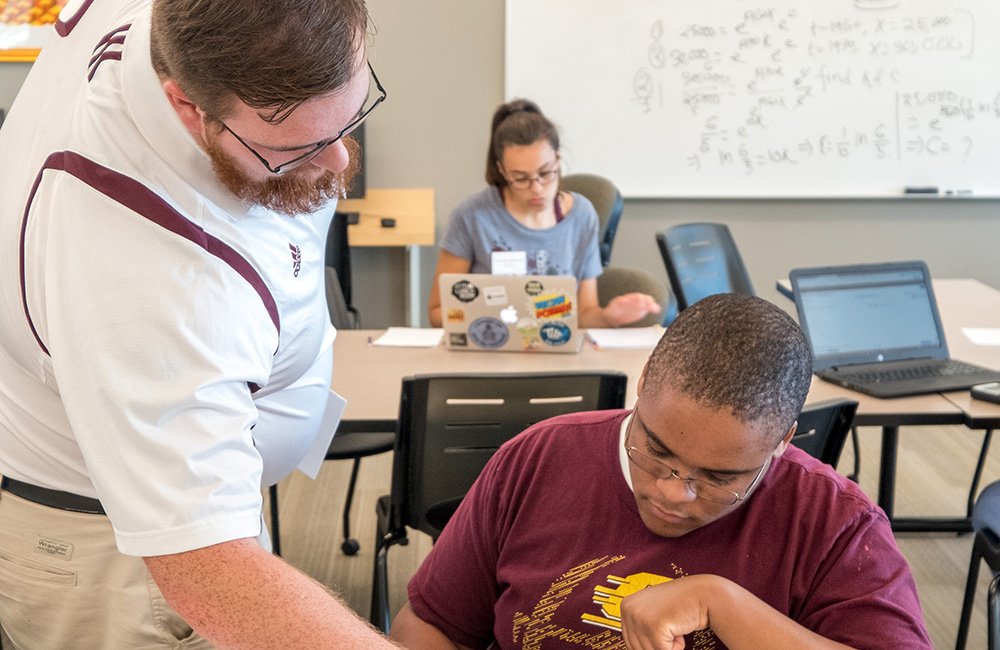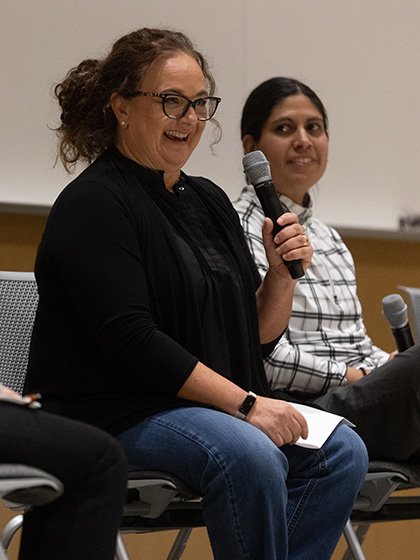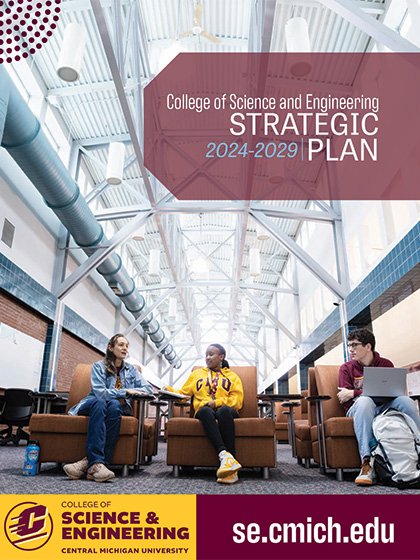Student Success - Including student success as a central goal in our CSE Strategic Plan fundamentally aligns with the core mission of CMU. Students are defined as the breadth of students from non-majors to majors, transfer, non-degree and life-long learners, and graduate students. We value all learners and recognize that success is multifaceted and encompasses academic growth, critical thinking, personal development, and career readiness. Moreover, a focus on student success emphasizes a commitment to fostering diversity, equity, and inclusion, ensuring that all students have the opportunities, resources, and support to reach their goals. Student success contributes to developing well-rounded, empowered individuals ready to make meaningful contributions to their communities and the world beyond the classroom.
STRATEGIES:
S1: Cultivate a learning environment that builds students’ abilities, talents, and skills by encouraging dedication, resilience, and creative problem-solving.
S2: Promote and strengthen existing co-curricular programs and connect students with experiential learning opportunities that build relevant transferable skills and competencies to foster leaders and civic responsibility.
S3: Inspire students to explore and pursue STEM fields and academic pathways.
TACTICS:
T1: Incorporate hands-on success skills and support for students pursuing STEM careers in the curriculum. (Strategies 1 and 2)
T2: Increase support for advising activities and further develop ongoing communications between the CSE Student Success Center and departments. (Strategy 1)
T3: Strengthen support for student activities that build community, enhance belonging, and promote professional development and co-curricular activities. (Strategies 1 and 2)
T4: Amplify student-driven accomplishments. (Strategies 1, 2, and 3)
T5: Review and realign non-major courses within CSE to align with the CMU General Education Program and other programs; identify common student learning outcomes related to scientific literacy for non-major classes. (Strategy 1)
T6: Invest in efforts to recruit and retain students in STEM fields. (Strategies 1, 2, and 3)
T7: Foster a culture of support for CSE graduate students and postdoctoral scholars. (Strategy 1)
T8: Provide and support additional learning tracks that allow students to access educational experiences beyond the traditional college path. (Strategies 1, 2, and 3)
T9: Normalize metacognition through webinars, talks, activities, and short courses to reinforce lifelong learning and science literacy. (Strategy 1)
T10: Ensure the dynamic and innovative teaching by College faculty and staff is continually supported and recognized. (Strategies 1, 2, and 3)
Diversity, Equity, Inclusion, Justice, and Belonging - Incorporating diversity, equity, inclusion, justice, and belonging into our Strategic Plan is imperative for fostering an enriching and equitable learning environment. Recognizing and embracing the diverse backgrounds, perspectives, and experiences of students, faculty, and staff enhances the educational experience and prepares individuals to thrive in an interconnected global society. By prioritizing equity and inclusivity, CSE can break down barriers to access for historically underrepresented groups in STEM and ensure that all community members have equal opportunities to succeed. Cultivating a sense of belonging is crucial for student engagement, retention, and overall well-being, fostering a community where everyone feels valued and supported.
STRATEGIES
S1: Explicitly foster a culture of belonging for all.
S2: Identify and work to remove barriers to success for historically marginalized communities within STEM.
S3: Reinforce a culture of inclusive teaching, mentoring, and professional support.
S4: Attract, hire, and retain faculty and staff from diverse backgrounds.
TACTICS:
T1: Develop and implement a plan to support historically marginalized students in STEM. (Strategies 1, 2, and 3)
T2: Reduce achievement gaps by providing structured mentoring programs. (Strategies 1, 2, and 3)
T3: Collect data to evaluate DEIJB efforts and impacts; communicate results to the CSE community. (Strategies 1, 2, 3, and 4)
T4: Implement strategies to attract a more diverse pool of applicants for faculty and staff positions. (Strategies 1, 2, 3, and 4)
T5: Review and revise CSE awards to reflect the values of CSE. (Strategies 3 and 4)
T6: Develop and implement means to better appreciate and support the diversity of all CSE students, staff, and faculty. (Strategies 1, 2, 3, and 4)
T7: Continue to support inclusive teaching workshops for graduate students, faculty, and staff. (Strategies 1 and 3)
T8: Collaborate with campus programs that support historically and currently under-represented students. (Strategies 1 and 2)
T9: Continue to promote and communicate successes from the InSciTE program toward broader adoption of inclusive pedagogies. (Strategies 1 and 3)
T10: Support writing of external grant and contract proposals that address culture change and inclusive communities. (Strategies 1, 2, 3, and 4)
T11: Communicate campus mechanisms to report incidents of misconduct, harassment, discrimination, or bias. (Strategies 1 and 3)
T12: Encourage incorporating relevant social justice issues and applied learning into course requirements whenever applicable. (Strategies 1 and 3)
Scholarship - Scholarship encompasses academic endeavors of all types, including impactful research, innovative, evidence-based pedagogy, and supportive mentoring. CSE is well-positioned to address many of society’s most pressing problems, and its goal should be to support the creative work needed to tackle them adequately. An internal challenge is a mismatch between the aspirations toward high-quality scholarship and the limited financial resources available within our existing budget. When many needs cannot be met, the College must be transparent in its decision-making and balanced in its support for our dual mission of teaching and research. To meet our strategic challenges, CSE must harness the strengths and passions of its faculty, staff, and students and promote closer collaboration and cooperation across its departments.
STRATEGIES:
S1: Establish College priorities for scholarly endeavors and align future investments to support these scholarly priority areas.
S2: Encourage departments to recognize and value scholarship that includes subject-specific research based on faculty expertise, including scholarship of teaching and learning.
S3: Provide career-focused mentoring to early-career faculty and encourage departments to provide career development opportunities to their students and postdoctoral scholars.
TACTICS:
T1: Investigate pathways for strengthening existing scholarly areas with a focus on growth opportunities. (Strategy 1)
T2: Develop and pilot innovative, data-driven approaches for leveraging personnel to better meet the range of scholarly expectations and challenges departments have in balancing workloads, talents, and strengths. (Strategies 2 and 3)
T3: Encourage review of bylaws to ensure impactful scholarship products that result from development of innovative teaching methods and subject-specific research expertise are valued during reappointment, tenure, and promotion decisions. (Strategy 2)
T4: Regularly share information about internal and external funding opportunities for students with undergraduate and graduate students and ensure that CSE graduate stipends are competitive in comparison to peer institutions. (Strategies 1 and 3)
T5: Sustainably grow the total number of tenure-track faculty in the College with a focus on academic areas that have potential for enrollment growth. (Strategies 1 and 3)
T6: Provide support for pre-tenure faculty and encourage departments to establish career-focused mentoring for students and postdoctoral scholars. (Strategy 3)
CSE Culture - Strengthening effective communication, sustainable operations, and the engagement of CSE students, faculty, and staff are fundamental for fostering a thriving and interconnected college environment where CSE becomes a destination of choice. Effective communication strategies enhance transparency, collaboration, and understanding among students, faculty, and staff, promoting a cohesive and informed community. Prioritizing sustainable operations establishes long-term fiscal stability and allows the College to focus on strength areas and opportunities. Community engagement ensures that CSE actively contributes to the well-being of its members, promoting mutually beneficial relationships.
STRATEGIES:
S1: Encourage positive and respectful interactions across the College where all members are valued and empowered.
S2: Improve internal communications throughout the College with a focus on data-sharing and input.
S3: Adjust resource allocations across the College to ensure long-term fiscal stability and promote shared decision making.
S4: Increase support for cross-college activities that foster relationships across disciplines.
TACTICS:
T1: Develop workload guidelines, including teaching assignments, that departments can utilize to leverage the talents of all their members. (Strategies 1 and 3)
T2: In collaboration with HR and FPS, regularly review salary structures of faculty and staff and ensure equity across College. (Strategies 1 and 3)
T3: Encourage inclusive participation of all members in departmental decisions. Establish best practices for committees and meetings. (Strategies 1, 2, and 4)
T4: Implement a transparent communication model that explicitly ties internal data to internal decisions. (Strategies 2 and 3)
T5: Increase opportunities for celebrating success of all members of CSE. (Strategy 1)
T6: Promote and support events that create a sense of community across the College, as well as provide opportunities for individuals to embrace CSE goals and values in their everyday activities. (Strategy 4)
Beyond CSE/Community Connections - Robust connections with community partners beyond CSE are critical for research innovation, educational opportunities enhancements, mutually beneficial community collaborations, and our improved reputation as a college. By actively engaging with businesses, K-12 schools, government entities, and nonprofit organizations, CSE establishes mutually beneficial partnerships that enhance educational opportunities, research collaborations, and community development initiatives. Furthermore, external community building bridges the gap between academia and industry, ensuring academic programs align with real-world needs and trends. This goal also promotes a positive university image, as it demonstrates a commitment to social responsibility and community impact, engenders alumni pride, and attracts potential students, faculty, and donors.
STRATEGIES:
S1: Increase connections between CSE and future students.
S2: Enhance collaboration and foster engagement with groups beyond CSE, including other colleges at CMU, alumni, industrial partners, government agencies, K-12 local school districts, the Saginaw Chippewa Indian Tribe, and non-profit organizations.
S3: Reimagine and continue to support communication strategies with outside entities.
S4: Set and execute an ambitious plan for CSE engagement and fundraising in the CMU Capital Campaign.
TACTICS:
T1: Grow and maintain an effective portfolio of opportunities to connect future students to CSE, leveraging participation from the CSE community and external partners. (Strategies 1 and 2)
T2: Increase the number and effectiveness of CSE's external partnerships. (Strategy 2)
T3: Improve engagement of all CSE members with volunteer and community work by (1) aligning with university efforts and (2) valuing and celebrating such engagement. (Strategies 2 and 3)
T4: Efficiently and effectively utilize the communications resources in CSE and, more broadly, at CMU to share our stories of engagement. (Strategy 3)
T5: Partner with Advancement and the Academic Division to ensure that CSE is fully engaged and successful in the University's upcoming capital campaign. (Strategies 2 and 4)



